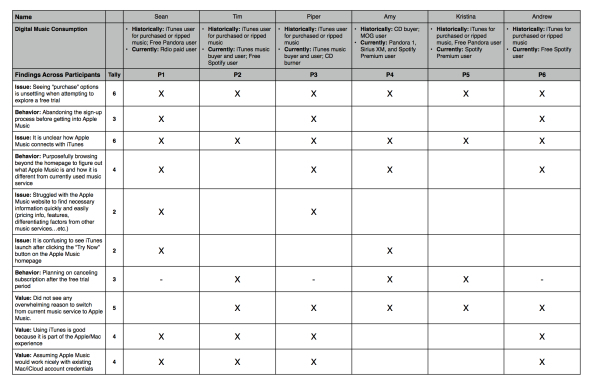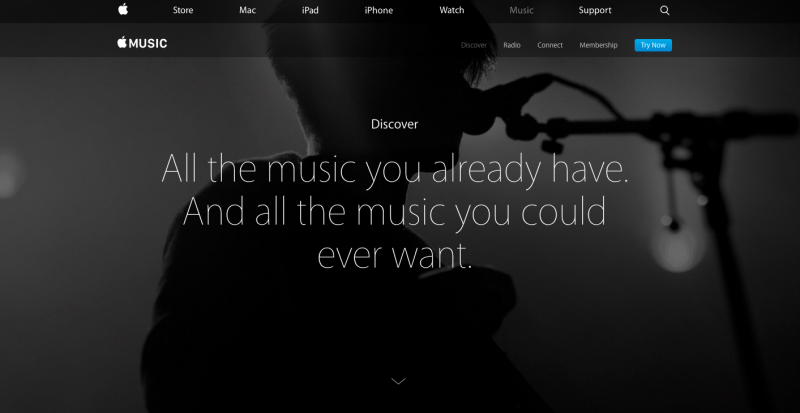
By
Ankitha Bharadwaj
In my last post, I talked about my motivations for looking into Apple Music, and my plan to suss out the positives and the negatives. I discovered some red flags that Apple may wish to address. Let’s dive into the details.
Findings
I spoke with six active digital music listeners about how they typically consume music. These six participants were then asked to look into Apple Music and provide feedback on their overall impressions of the service and its features after using it in the session.
After six one-hour sessions, here’s the most important finding:
Three of the participants (that’s half!) abandoned Apple Music during the sign up process. The remaining three intended to cancel their memberships at the end of the free trial.
This is not good news for Apple Music. Half of the participants didn’t even make it into Apple Music before deciding to jump ship. So what happened?
I believe the onboarding of new users is peppered with barriers for entry with Apple Music. Here’s why.
1. “I don’t feel confident in my understanding of Apple Music and its offerings.”
Right off the bat, all six participants weren’t totally sure what Apple Music was. Sure, it’s a streaming music service, but what makes it different from the others? What’s the incentive to bail on Spotify and switch to Apple Music? All six participants spent quite a bit of time scrolling through the Apple Music website on their laptops to find out answers to these questions.
Sean spent close to 40 minutes reading all the different sections, but still had doubts about what the service offers. Piper started getting annoyed with the website.
I want to know about Apple Music! I just want more information right here. You can have the cool photo in the background but you don’t have to have these teasers. I don’t need a ton of text to read through. I just want a brief synopsis of what Apple Music is. —Piper
Though she appreciated Apple’s flare for design, this was not the place for it.
For most of the participants, the cost of the subscription was the first question they had. This info is under the “Membership” tab, and not everyone spent enough time on the website to find this information.
Andrew wasn’t sure what exactly he would be getting if he clicked on the “Try Now” button. Would he be downloading an app? Would he be rerouted to a web-based app? Who knows! The homepage, with its full-screen pictures, and moving descriptions like “All the music you already have. And all the music you could ever want,” got everyone excited about Apple Music. But the excitement was short-lived when the website failed to provide them with concrete information about what the heck Apple Music does.
Opportunity: Apple needs to provide a quick and easily digestible rundown of Apple Music facts without requiring the user to scroll a whole bunch.
- What is it? An app? A website? A device?
- How much does it cost?
- What do I need to get started?
Spotify’s homepage is a solid example of just what I’m talking about.
2. “I’m not sure how Apple Music connects with iTunes.”
All six participants were familiar with iTunes and had used it multiple times in the past for purchasing music, playing music, and listening to podcasts. Almost all of the participants immediately questioned how Apple Music would work with iTunes. The website does very little to address this point.
There were conceptual issues. For example, Piper and Sean weren’t sure why they would need to purchase music from the iTunes store if they had access to the entire catalogue on Apple Music. This signals confusion at the core of what Apple Music is all about. Is it inherently a part of iTunes? Is it something you have to sync with iTunes?
It’s totally ambiguous from the start what Apple Music was in conjunction with iTunes. —Sean
Let’s not forget that iTunes has had a spotty history. Remember when iTunes would only allow you to sync your iPod with one computer? And if you tried to hook your iPod into another Mac, iTunes would threaten to wipe your iPod clean? Andrew had serious trepidation about moving ahead with Apple Music because he figured it would be tied to iTunes Radio and therefore iTunes. Moreover, as a PC user, Andrew felt like he would have a subpar experience with Apple Music. His experience with iTunes on the PC forced him to take pause and wonder if the anxiety attacks were worth it.
iTunes on PC is a bit unstable and it can cause the computer to lock up. It’s not easy to run iTunes in the background. [I would not sign up for Apple Music] because of iTunes’ track record and [the fact that] I’m operating it on the PC. It’s not really the music service’s fault, but the program they’re using to deliver it. —Andrew
On the flip side, three of the six participants were fans and active users of iTunes, and saw it as a potential reason for getting into Apple Music. Let’s get into that next.
Opportunity: The messaging on the Apple Music website is very ambiguous and does not clearly communicate to potential users that it is a service that is linked to iTunes.
The site alludes to this connection with the statement “All the music you already have. And all the music you could ever want” on the “Discover” tab, but participants wanted clarity right on the main landing page without having to explore other content areas.
3. “I feel uncomfortable seeing options to buy when I’m exploring a free three-month trial.”
Here is the biggest barrier for getting into Apple Music. All six participants were immediately spooked when they saw a purchase confirmation dialogue box pop up when they selected a membership option. All along, the six participants made note of the free three-month trials that encouraged them to give Apple Music a once over.
The word ‘buy’ is a little strange to me. I’m doing a free trial and I‘m signing up for something. It’s asking me to sign in and the button says ‘buy’, not ‘sign up’ or ‘sign in’. —Tim
We’re all familiar with limited-time free trials, and we know it’s a popular and successful way to get people into a product or service. The issue here is that Apple required a payment at the very beginning instead of allowing people to get a feel for the service and decide for themselves. There was a sense of being trapped or locked into something with no way out. Here is where three of the six participants decided to quit. They did not feel confident that their credit cards won’t be charged, or they didn’t want to have to go back and haggle with Apple to get the money refunded.
All six participants found this far too cumbersome, and mentioned that they don’t feel like it was worth the effort. Kristina was completely satisfied with her Spotify Premium account and found Apple Music to be a hard sell.
But why do I need a credit card? This is where I would have dropped off. If I was home, I would not be getting my card out. —Kristina
Three participants did decide to go ahead and “buy” a membership. But they did not intend to maintain the membership.
I don’t want to choose a plan because I thought it was free! I just have to remember to cancel this. —Amy
Opportunity: Instead of scaring people off with asking for payment information in the beginning, Apple has the opportunity to get people into the app quickly, and getting them excited about the service. They’ve got a great product, and it’s a shame that 50% of my participants didn’t even get to see it.
Apple could allow people to sign up and get in quickly, then provide timely messaging as users get closer to the end of their three-month free trials. There may be opportunities to upsell continuing the membership. The idea is to give the power to the user: Allow them to maintain their membership of their own volition, instead of trapping them in from the get-go.
Wrapping up
All things said and done, it’s obviously true that Apple Music will be a successful music service. A company that gets hundreds of people lining down and around the block for a phone doesn’t make imprudent decisions or launch half-baked products. But there is an opportunity to guarantee this service’s success by addressing these onboarding issues.
Apple has the opportunity to convert those who have approached streaming music with trepidation by making it quick and easy to get into the service and pique their interest straight away. More importantly, Apple has the opportunity to attract Mac fans and keep them in the ecosystem.
Five of the six participants were current MacBook and/or iPhone users. Four of these five felt that Apple Music would be quick and easy to get onboard with because they are already familiar with the Apple brand.
Apple Music is already in the Apple ecosystem so I wouldn’t have to learn a new system. —Tim
I have an iPhone, Apple TV, iPad. I like the Apple stuff. —Sean
This was the biggest draw for me as well. Staying part of the Apple ecosystem is pretty phenomenal: Airplay makes it easy to transfer files between my Apple devices, and iMessage lets me send those cat emojis from my iPad, iPhone, or either of my two MacBooks. This seamless connection between Apple devices and software has been a huge delighter for many who stay within the Apple ecosystem.
And it makes sense for Apple Music to connect with iTunes. The iTunes brand is strongly tied to high quality / high quantity music. So Apple is on the right track with where they are headed. Piper said it best, “iTunes is safe. It comes with the machine, it’s part of the Mac experience. You don’t have to go outside to get anything.” Yet she bailed on Apple Music even before launching it. She got overwhelmed by the lack of information about the service and the confusion about paying for a free three-month trial.

There’s no doubt that Apple Music will soon become a formidable player in the streaming music game, but addressing these onboarding issues will greatly ensure the success of the service. There is a huge opportunity for Apple to streamline the sign-up process to nab those people who have been on the fence about streaming music services. Making it quick and easy to get into the app and start playing around would attract those newbies while also bringing back or keeping Apple fans like Piper in the ecosystem.
